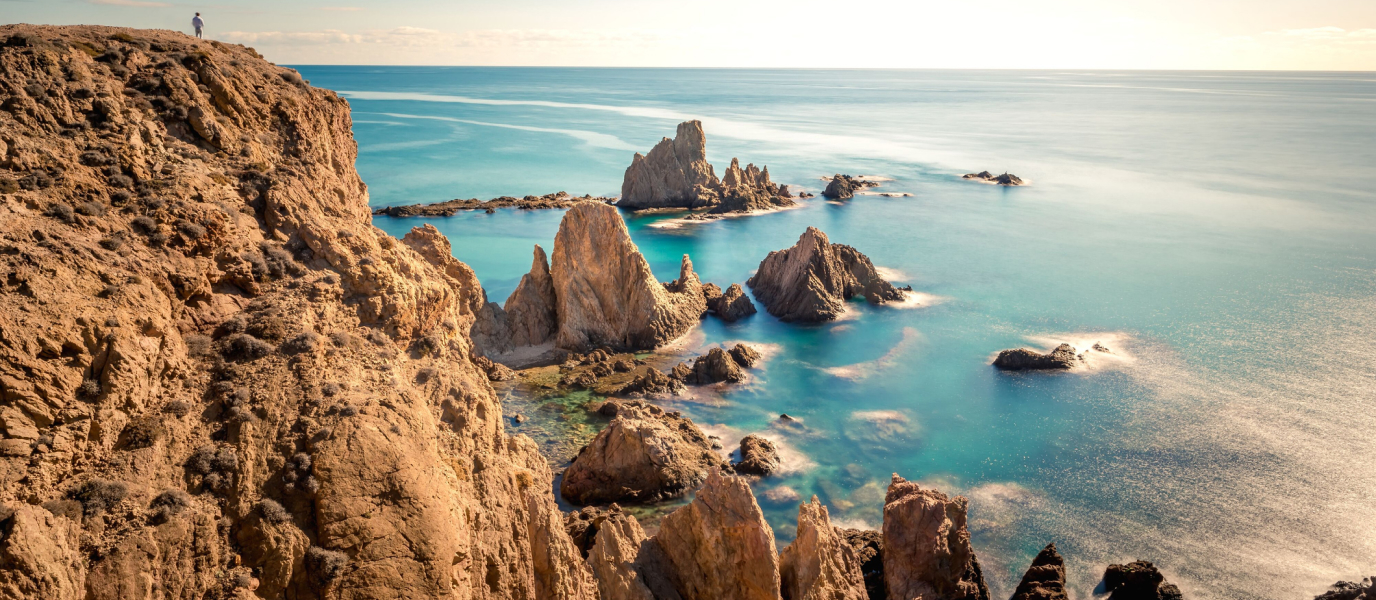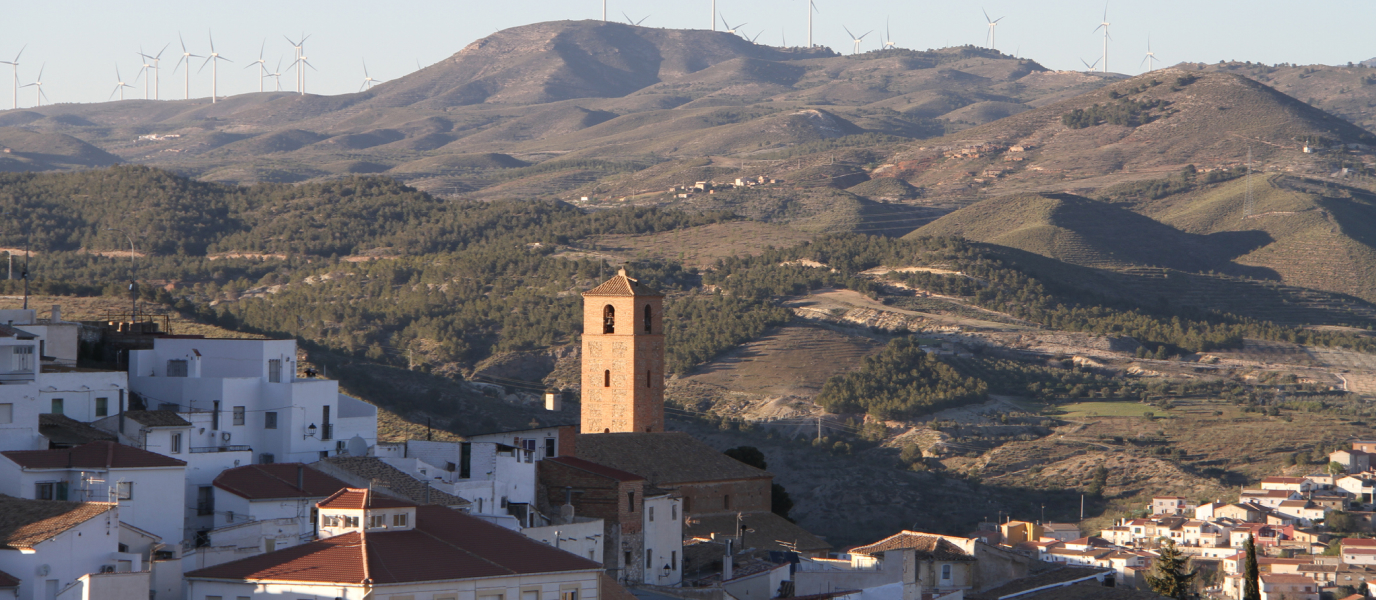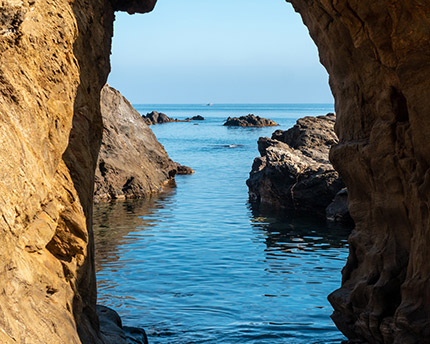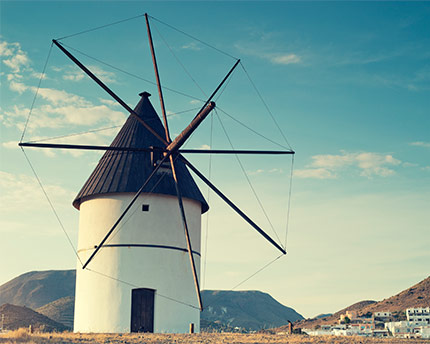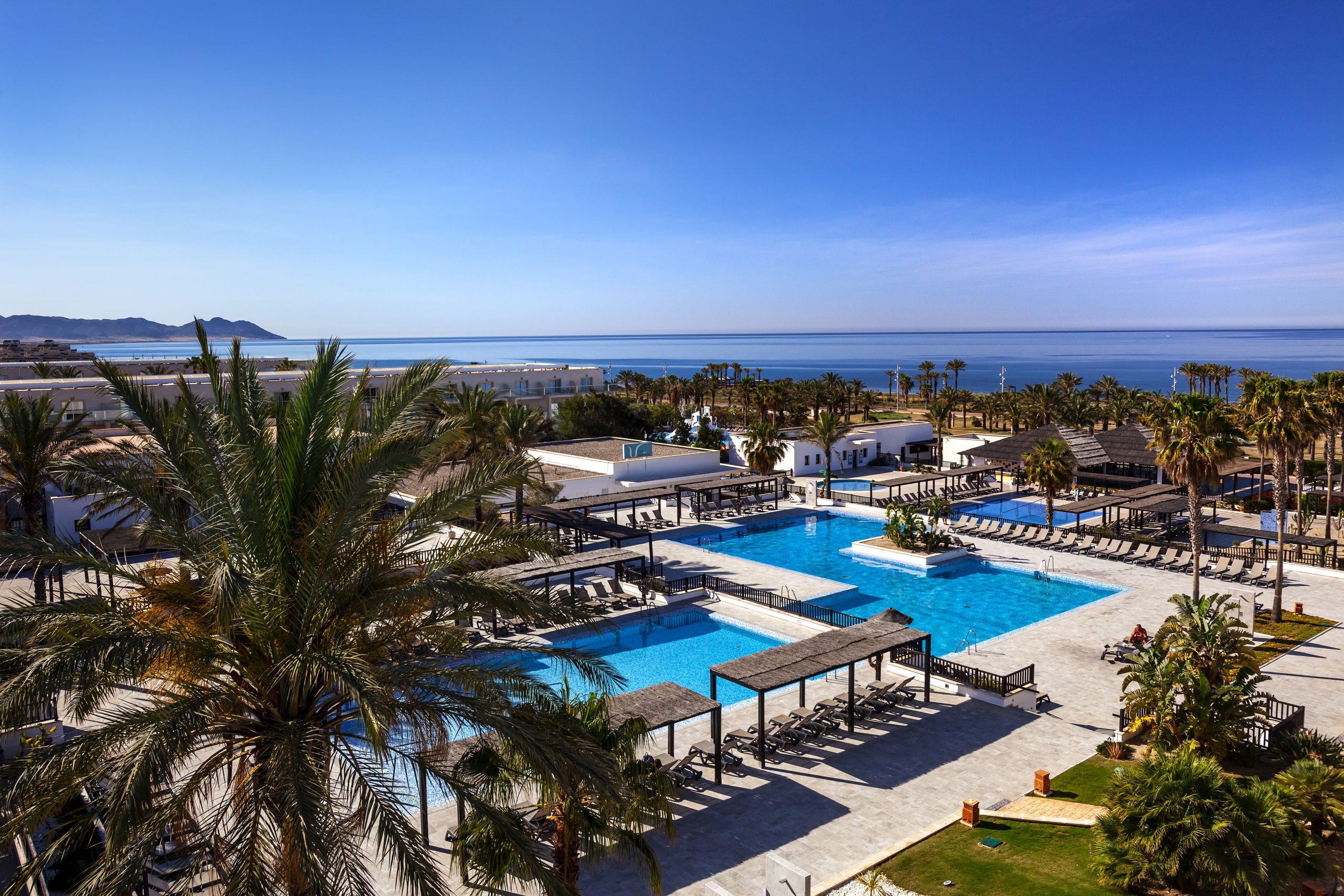The province of Almería enshrines as many paradoxes as life itself. There is so much more to Almería than the tired, hackneyed image of its deserts and its seas of plastic. This is a region of contrasts, with many unspoilt beaches, steep cliffs, green hills, and small towns and villages built in a Moorish style. Here, we can find Playa de los Muertos [Beach of the Dead] — which is, in fact, full of life. And we can tour that part of Alpujarra that lies within Almería. At the same time, this region includes the volcanic landscape of Cabo de Gata, the Karst de Sorbas gypsum caves, and the western towns and villages of the legendary Tabernas desert. In a nutshell, the province of Almería offers a whole plethora of delights to visitors of all ages and interests. Will you join us? We’ll show you.
Related experiences
Almería capital
The city of Almería, the capital of the region of the same name, can trace its origins back to a seafaring district of the prosperous Arab colony of Bayyana ― the modern town of Pechina – over a thousand years ago. Projecting out into the beautiful Gulf of Almería, and hemmed in on the inland side by the Gádor and Alhamilla mountain ranges, visitors will find modern-day Almería a small but welcoming city, with plenty of attractions well worth seeing. The Alcazaba, the largest fortress built in Spain by the Arab dynasties, is possibly the city’s main attraction. Second in popularity is the Catedral de la Encarnación, an impressive fortress-like Christian edifice, built in the sixteenth century to withstand the pirate attacks to which the coast was constantly subjected. Visitors can trace the history of this age-old city at Almería Museum — originally founded as an archaeological museum in 1933 — which holds an extensive collection dating from the Paleolithic Age up to the present day. And, finally, if you’d prefer to explore the more recent history of Almería, we recommend you make for the Plaza de la Constitución ―dominated by the monument to the Martyrs for Freedom―, and the Civil War shelters, a network of underground passageways and military bunkers that have been adapted to cater for educational visits.
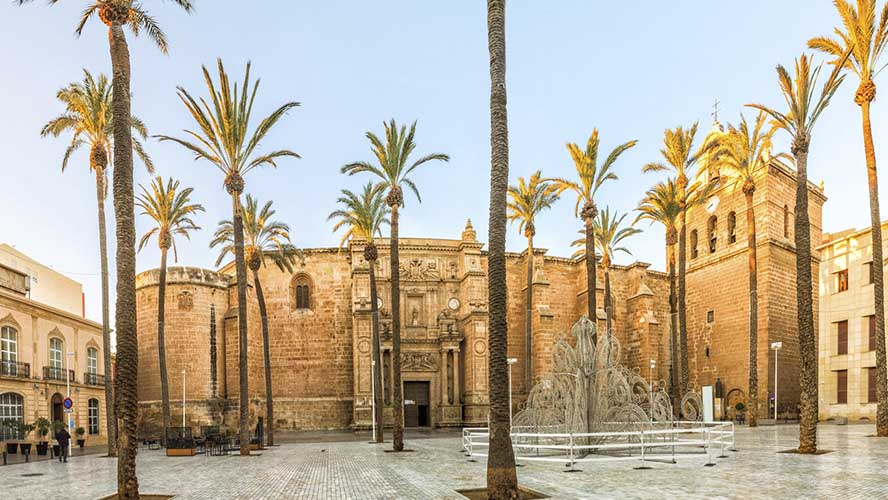
Mojácar
Now, as you can see, there is plenty to keep you occupied in Almería capital itself, but you would be remiss if you came this beautiful province and didn’t take the opportunity to visit the sites surrounding its capital. The best-known village outside the capital would be Mojácar thanks to its picturesque white houses and Mudejar architecture. Located just 90 kilometres from the capital, at the foot of the Sierra de Cabrera mountains, Mojácar has two main centres: the Old Town and the beach. The first is located in the centre of the town and it dazzles its visitors with its narrow streets, flowerpots hanging from its balconies and a near endless amount of archaeology. The second is known locally as the ‘Ibiza of the South’ because of the large quantity of residential complexes, hotels, bars and nightclubs it boasts. As well as the offer of great nightlife, the beach area also offers 17 kilometres of crystal-clear water on beaches such as Macenas Beach and Lance Beach.
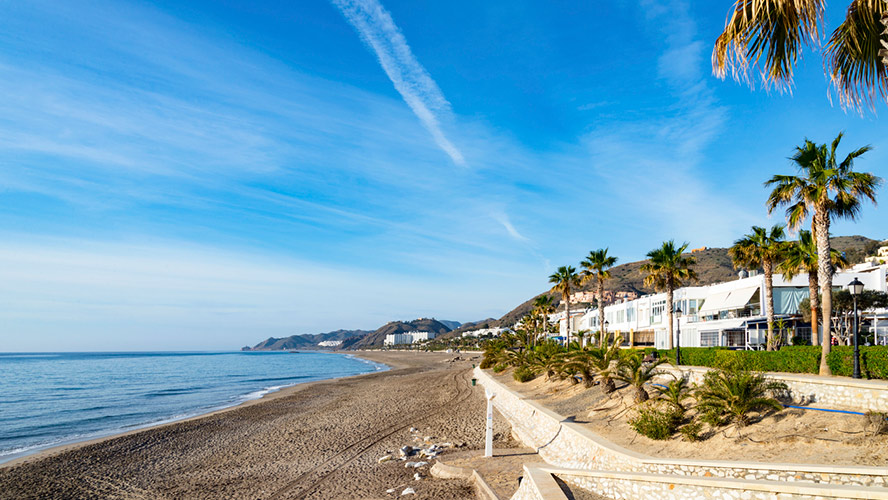
Roquetas de Mar and Santa Ana Castle
Continuing a tour of Almería’s beautiful villages, you won’t regret a visit to Roquetas de Mar and its imposing Santa Ana Castle. Located in the south-east of the province, just 21 kilometres from the capital, this municipality is made up of not just the Old Town but such other tourist-favourites as Aguadulce, Parador de las Hortichuelas and Las Marinas. A large part of Roquetas de Mar is also taken up by the Punta Entinas-Sabinar Natural Reserve, a series of sand dunes, beaches and ponds with an extraordinarily rich diversity of wildlife.
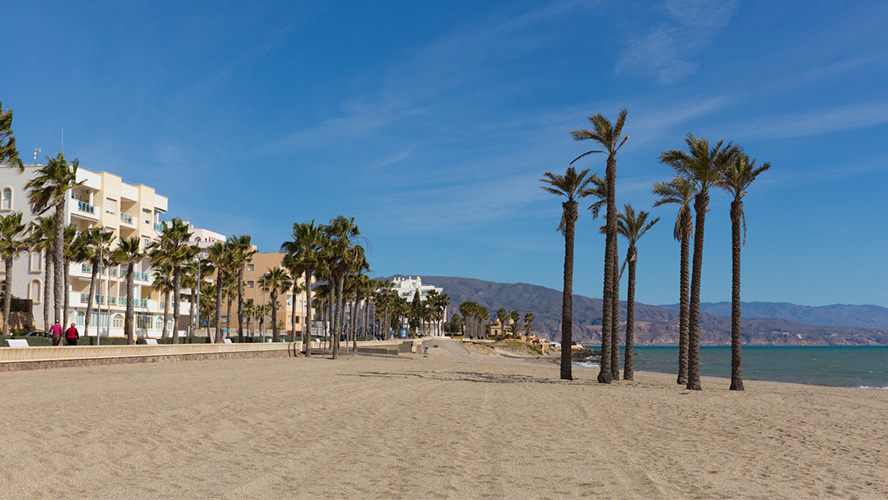
If Roquetas de Mar stands out amidst Almería’s villages it is because of the sheer amount of attractions it has to offer, from its alluring monuments – like the Santa Ana Castle or the Sabinar Lighthouse – to the seaside promenade full of bars and restaurants. Its beaches are no less noteworthy – such as Aguadulce, Romanilla and Bajadilla – most of which have been awarded the European Union’s highly coveted ‘Blue Flag’ for cleanliness and safety. If you prefer a little more activity in your leisure, then you can’t go wrong with a trip to its two water parks ―MarioPark and Aquavera― or its impressive aquarium.
Níjar
If you love the contrast of mountains and beaches, then you should take a trip inland and visit the most populated municipality in the province: Níjar. It composes part of the Cabo de Gata-Níjar Natural Park, an amazingly rich geological area declared a ‘Geopark’ by UNESCO in 1999.
The capital of this municipality – also called Níjar – is located just 30 kilometres north-east of the capital, at the foot of the Sierra de la Alhamilla mountains. Literature lovers flock here every year to see the resounding beauty of the scenery that was the backdrop to Federico Garcia Lorca’s most celebrated work of theatre, Blood Wedding. The village of Níjar, with its white houses clustered together on the mountainside, dazzles the incoming visitor like a pure white pearl nestled in the greenery of the fields that surround it. Here you can visit many buildings in the Mudejar style such as the 16th century Church of Santa Maria de la Anunciación. There are also stunning beaches, such as Monsul beach, which is one of the most beloved beaches in all the Almerian coast. A simple walk from the Old Town allows you to look in on artisan workshops that are the inheritors of traditions handed down to them over 500 years from the time of the Moors. These artisans work with jarapa, a durable and tightly-wound fabric used to make rugs, blankets and other home accessories that make for excellent souvenirs.
Carboneras
The Cabo de Gata-Níjar National Park not only extends to another popular municipality in Almería, it actually constitutes 75% of the town. Carboneras boasts 15 kilometres of mostly virgin beaches and a seemingly unending amount of archaeology so it is well worth a visit too.
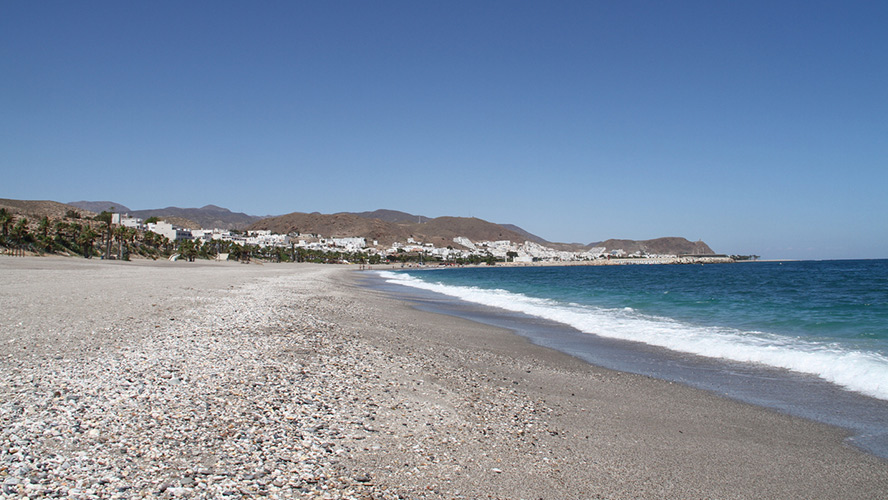
The municipality’s capital – also named Carboneras – is known locally and affectionately across Almería as ‘The Town’ due to the fact that it has kept its traditions as a fishing town adamantly over the years and, therefore, its inhabitants have curated a very traditional lifestyle that they continue to practice to this day. There you will find the Town Hall, which is a large palatial house in the style of those built in South America during the 19th century and also the San Andrés Castle, which was built towards the end of the 16th century to defend the coast from Berber pirates.
Along its beautiful seaside promenade you will find a plethora of restaurants and bars where you can stop to have lunch or just an ice cream while taking in the stunning views of the beaches in Carboneras – such as Los Cocones, Barquicos and La Puntica. In fact, just in front of this last beach, a couple of hundred metres out to sea, is the Island of San Andrés, a volcanic rock formation that is now home to many seabirds like the Yellow-legged Gull. It also provides an interesting backdrop to the many water sports that people practise there, such as windsurfing and snorkelling.
The Tabernas desert and Oasys MiniHollywood theme park
Thirty kilometres north of the city of Almería, the landscape becomes seriously awe-inspiring. Few places in Europe are as arid as the Tabernas desert a vast, barren plain that opens out before the visitor, attracting with its enigmatic silence, but at the same time repelling with its apparent lifelessness. This is the paradox of the only officially recognised desert in the whole of Europe — while its labyrinth of dry ravines, deep gullies and hidden caves may encourage us to think that nothing happens there, we cannot doubt that in fact this landscape holds hundreds of stories worth telling. We refer, of course, to the three Wild West towns that, since they were built as film sets for ‘Spaghetti Westerns’ in the 1970s, have never ceased to attract cinema lovers (and non-cinema lovers) from all over the world.
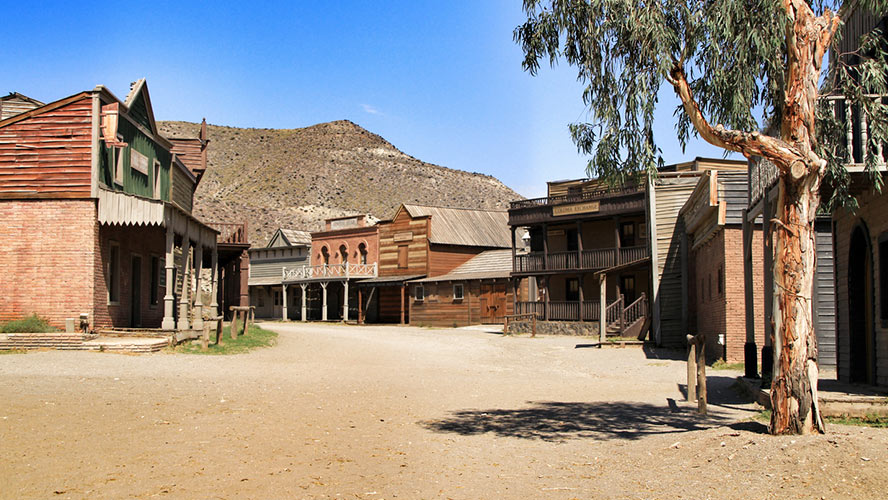
It is Oasys MiniHollywood theme park, the Oasys MiniHollywood theme park that has established itself as the star attraction, due to the fact that it was the birthplace of Sergio Leone’s ‘Dollars’ trilogy. Today, this attraction, located at kilometre 464 on the N-340 road, boasts three interesting claims to fame: it is a Wild West town with three shows per day; it has a zoo with over 800 animals of 200 different species, and it has a water park with swimming pools and relaxing bathing areas.
Cabo de Gata-Níjar Natural Park
Although Cabo de Gata-Níjar Natural Park has already been mentioned, it deserves its own section here. This 46,000-hectare reserve, formed by volcanic eruptions in the past, is to be found at the south-easternmost point of Almería province and it offers far too much to quantify in this short section.
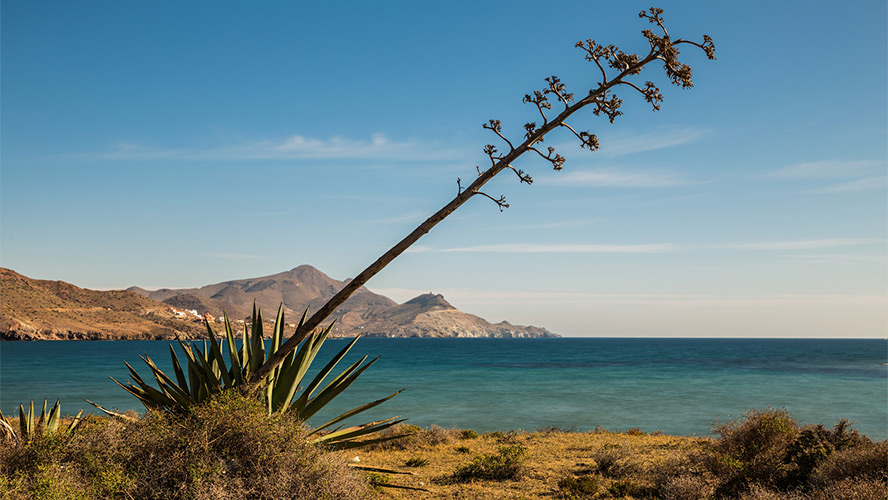
Halfway between the coast and the mountains, the park contains many towns and villages whose ‘Andalusian’ style and identity has been exceptionally well preserved over the years. Two excellent examples of this would be the villages of San Miguel de Cabo de Gata and San José and they are both well worth a visit. As well as these villages, you will find a series of fortresses that still keep an eye on the once perilous Mediterranean, such as the San Felipe fortress in Los Escullos village and the Torre de la Vela Blanca, an ancient coastal beacon near the Cabo de Gata Lighthouse.
Cueva de Sorbas
In the eastern part of Almería province you can also visit a series of subterranean caves known as the Yesos de Sorbas. Yesos translates as gypsum and lends its name to these caves because they are the best example of this type of karstic terrain in Spain. Sorbas refers to the municipality where these caves are to be found, located between the Sierra de los Filabres mountain range to the west and the Sierra Cabrera range to the east.
Declared a Natural Park in 1989 and a Special Area for Bird Protection in 2002, this arid corner of Almería offers 2,375 hectares of all kinds of rock formations (stalactites, stalagmites, coral, columns, cave pearls, etc.). To name just two of the many beautiful caves in the area, the Cave of Water (La Cueva del Agua) is the largest, measuring 500 metres in length and the Covadura Cave is the deepest, being found 120 metres below the earth.
In the town of Sorbas – located just 53 kilometres from the Almerian capital – you can hire the services of Cuevas de Sorbas Natur-Sport, a local company specialising in all kinds of speleological tours – basic, technical, teaching – through these limestone caves and tunnels. Be sure to book in advance, though.
Almerian Alpujarra
After covering the better part of the eastern side of the province of Almería it is time to take a quick look at the western side, where the mountain ranges of Sierra de Gádor and Sierra Nevada dominate the landscape. It is at the foot of the latter where a series of beautiful towns and villages cluster together in an area known as Almerian Alpujarra.
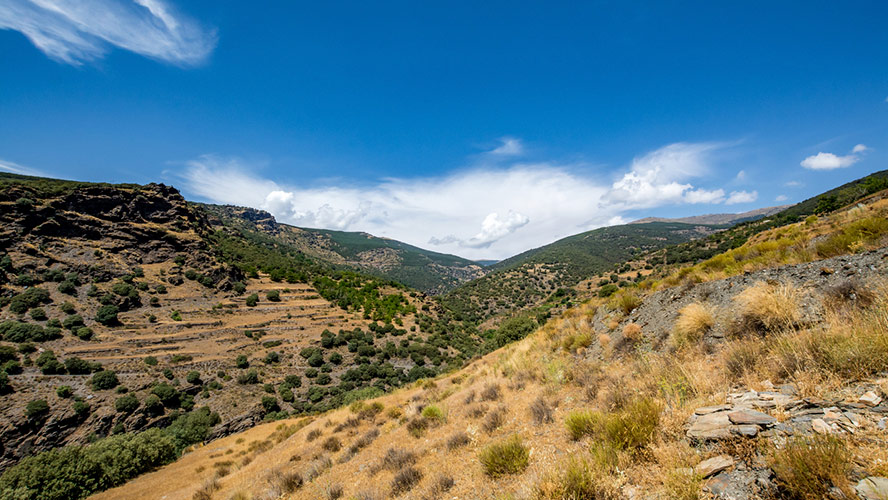
The entrance to this group of villages is to be found in the town of Alhamilla de Almería, made famous by the ‘medicinal mineral waters’ of its natural spa Balneario San Nicolás. From here, take the A-348 motorway towards Granada, which will skirt the Sierra Nevada mountain range while taking in no fewer than 22 towns and villages whose connection with the Moorish history of Spain has never been broken. Taking this road, you will get to know the famous Canales de Padules, a stunning series of channels and wells dug out by the flow of the River Andarax. This journey will also bring you to Almócita and its famous Moorish water cistern, one of the oldest in the region. In Laujar de Andarax, heart of Almerían Alpujarras, you can see the magnificent Mudejar Church of the Incarnation and, if your appetite demands it, you can sample some of the finest local cuisine local, such as the beloved plato alpujarreño, at La Fabriquilla.
The Pulpí Geode, a natural jewel
Discovered in 1999 inside the Mina Rica in the village of Pulpí, this is Europe’s largest mineral geode, and the largest one in the world that is open to the public. The geode lies at a depth of 60 metres; it measures eight metres long by two metres wide, and is covered in large, striking gypsum crystals. According to expert opinion, the transparency and excellent state of preservation of the Pulpí Geode, also known as the geode of Pilar de Jaravía, make it a unique worldwide phenomenon. In addition to this immense geode, Pulpí’s Mina Rica, located in the Sierra de Aguilón, is also the site of other fascinating mineralogical features: geological folds, mylonites, fault surfaces, and other geodes of varying sizes, including the Geoda Partida and the Geoda de Colas de Golondrina. The guided tour of the Pulpí Geode also takes in the main galleries of the Mina Rica. The price of general admission is 22 euros.
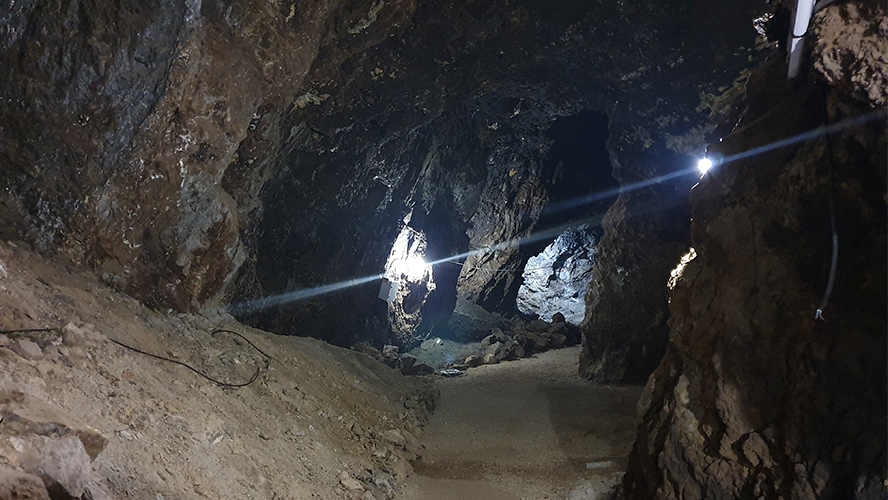
The towns of Vélez-Blanco and Vélez-Rubio
These two pretty white towns in the north-west of Almería, Vélez-Blanco and Vélez-Rubio, are the main population centres of the Comarca de los Vélez.
Vélez Blanco is a wondrous place, with the iconic Castillo de los Fajardo perched above it. This castle-palace once belonged to the Marquis of Vélez, and was designed by Italian artists and sculptors. It is a shame that the castle’s main courtyard, decorated with Macael marble, was sold in 1904, and is now in New York’s Metropolitan Museum of Art. Just below the castle is the Morería, the Moorish district, and the oldest part of the town, where the Muslim population lived until 1570. It is also worth seeing the Iglesia de la Magdalena; the beautiful, eighteenth-century drinking water fountain, the Fuente Caños de Caravaca; the church of Santiago Apóstol, the Casa de los Arcos, and the Convento de San Luis. Near the town is the Cueva de los Letreros, a cave containing the famous Indalo, a prehistoric painting portraying a human figure which has become an emblem of the province of Almería.
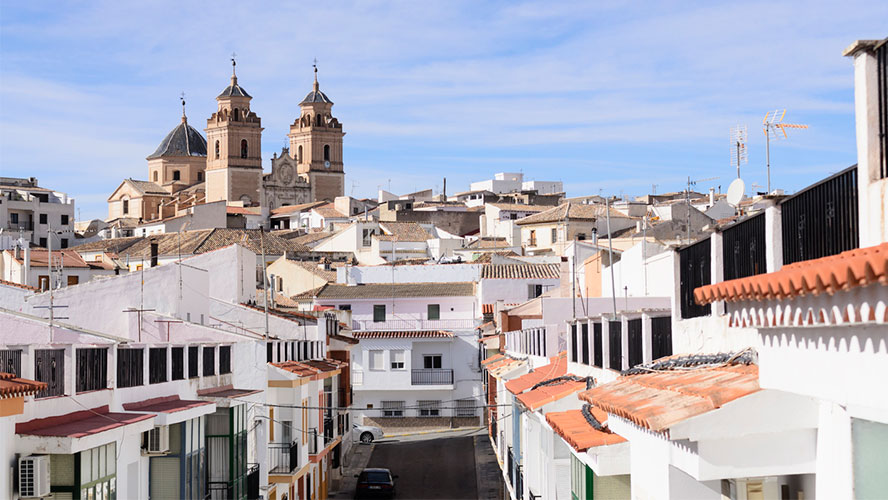
Attracting fewer tourists than Vélez Blanco, Vélez Rubio is nevertheless a town with a great deal of charm. Its historic quarter boasts a number of Baroque buildings, including the Iglesia de la Encarnación, a church with two towers constructed in brick, and the provincial museum, the Museo Comarcal de Arqueología Miguel Guirao, which displays important prehistoric pieces as well as others from the Roman and Moorish periods. On the hill known as the Cerro de Castellón, visitors can still see the remains of the ancient fortress said to have been the residence of Boabdil, the last Nazari king of Granada.
Sierra de los Filabres: nature and history
This mountain range in the west of Almería province has an extremely rich cultural and natural heritage. Prehistoric archaeological sites, the remains of Roman aqueducts, and Moorish fortresses can all be found here, in addition to pretty little villages of white cottages and steeply climbing streets such as Olula de Castro, Albánchez and Castro de Filabres. Gérgal is home to the Calar Alto Astronomical Observatory, Europe’s largest such observatory. And the Sierra de los Filabres mountain range provides wonderful hiking trails.
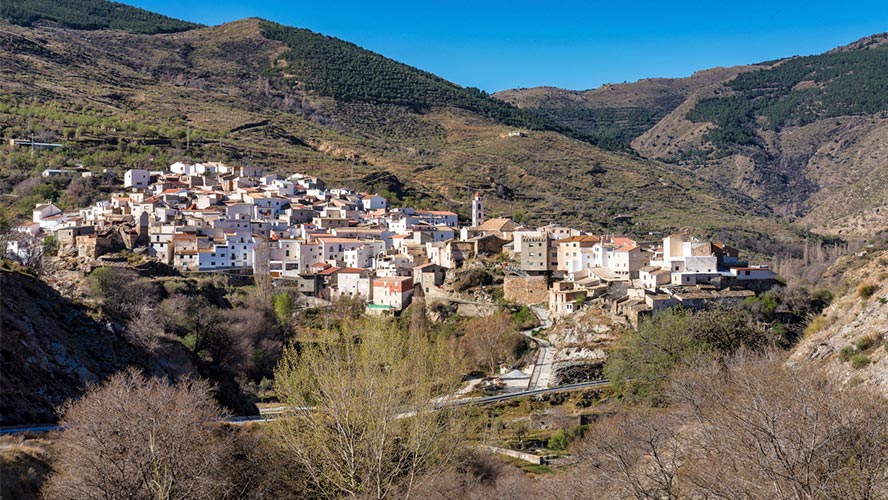
Almería’s most famous beaches
With beaches stretching over 200 kilometres, from Adra as far as Pulpí, Almería’s coast is a most appealing destination for those who like to take a dip in the Mediterranean. Below, we tell you about some of the most well-known beaches along the coastline:
Playa de los Muertos
To the south of Carboneras, six kilometres along the AL-5106 road, lies one of the greatest natural treasures, not only of this province, but of the whole of Spain. The Playa de los Muertos [Beach of the Dead], often described in the media as one of the country’s most beautiful beaches, is an enclave of white sands and crystal-clear waters. Its remote setting at the foot of cliffs has helped to preserve its unspoilt nature. From the nearest car park, three paths of differing levels of difficulty lead to the beach, just a few minutes away.
In the vicinity, there are also famed monuments of historical interest, including the Mesa Roldán castle, an eighteenth-century stronghold which, during the heyday of piracy was considered highly dangerous by the authorities. It was declared an Asset of Cultural Interest in 1949, and today its ruins can be found near the Mesa Roldán lighthouse, a white edifice dating from 1875, which replaced the traditional warning beacons.
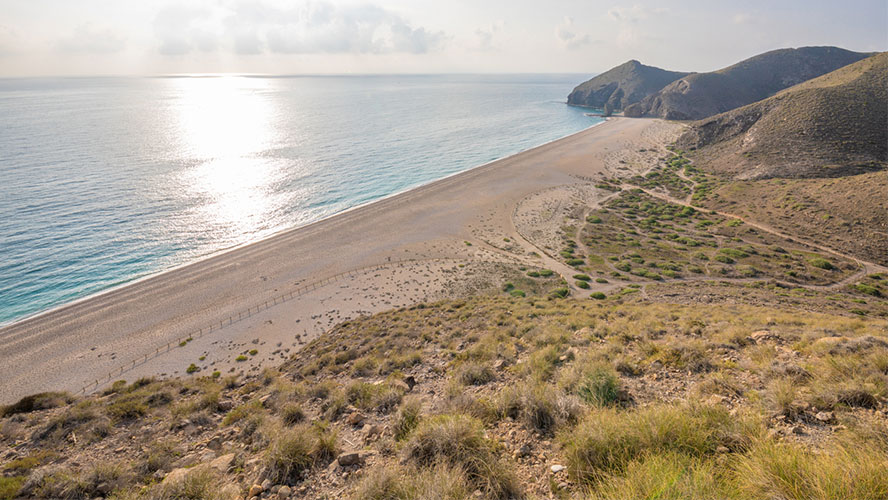
Mónsul beach
One of the province’s best-known and most popular beaches, Mónsul beach forms part of the Cabo de Gata-Níjar natural park, a few kilometres from San José. One of its most recognisable features is the immense rock that rises up from the sands, amid strangely shaped geological formations.
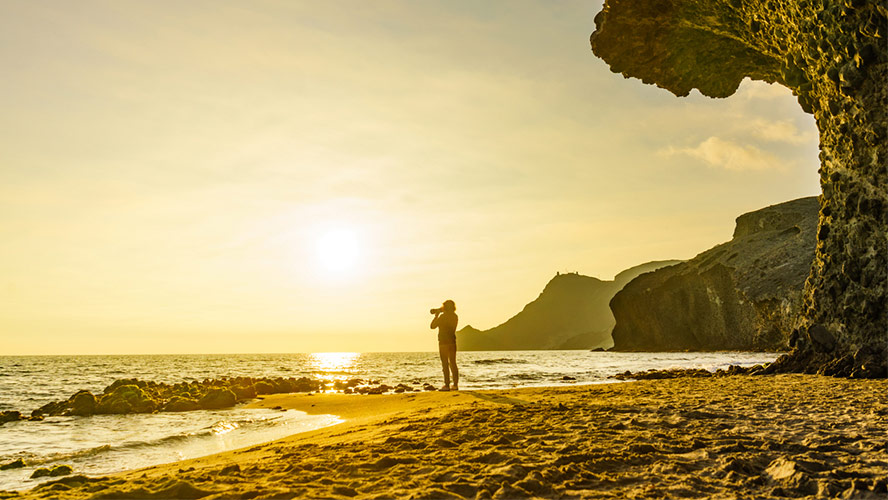
Playa de los Genoveses
Playa de los Genoveses lies in a completely unspoilt bay, very close to Mónsul beach. It affords impressive views of the Morrón de los Genoveses, a volcanic promontory. Those who climb to the top of the promontory will be rewarded with excellent views of the natural park.
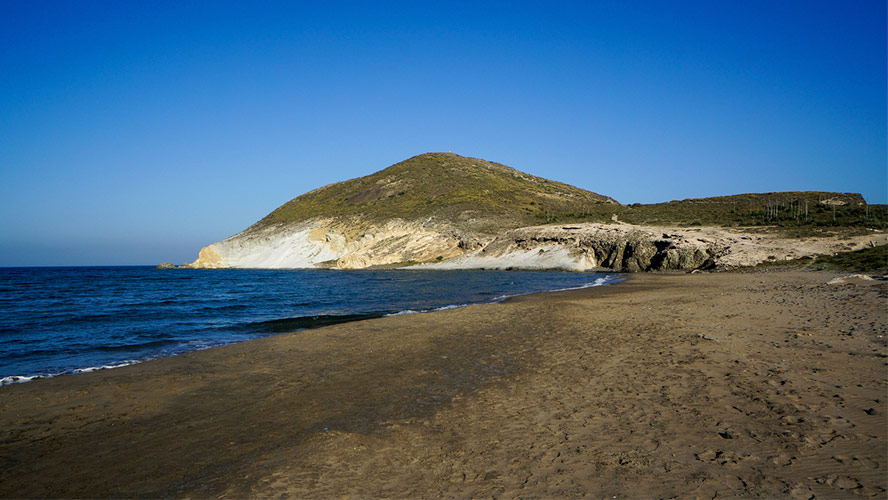
Playa de las Negras
This is a delightful beach, popular with families, that offers all kinds of services and facilities, including showers, coastguards, car parks, etc. A very pleasant place to go with children. There is a ferry service from this beach to the isolated cove of San Pedro, which can also be reached on foot — the walk takes around an hour.
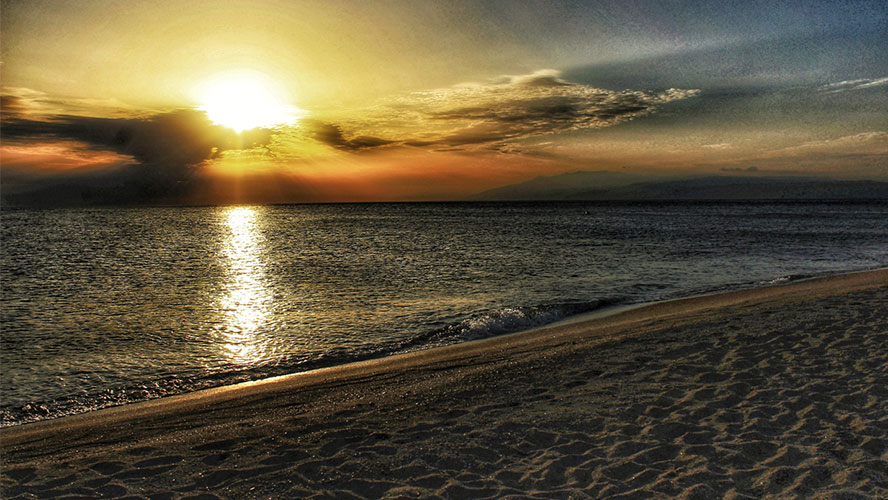
Cala de Enmedio
This is one of the loveliest beaches to be found along the coastline of Almería. Cala de Enmedio, a cove that stretches for barely 150 metres, is very close to Agua Amarga. Cala de Enmedio’s most interesting feature is its fossilised dunes, white geological formations that strike a contrast with the turquoise blue of the water, and which form jutting tongues of stone and natural wells of translucent water. “The New York Times” has included Cala de Enmedio on its list of the Mediterranean’s best beaches.
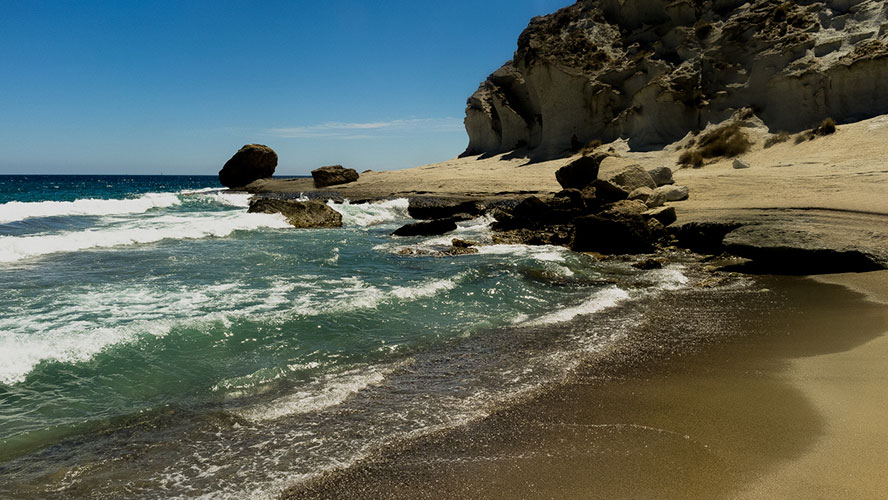
Laujar de Andarax, the village of 16 fountains
Located in the Almería Alpujarra, this attractive and historic village of 1,500 inhabitants is the result of the union of two centres of population: El Auxor and El Hizam. The village’s historic quarter is worth visiting, as it boasts several monuments, including the Iglesia de la Encarnación, a seventeenth-century church with a Mudejar-style exterior and a Baroque interior, and the Puente de los Moros [Moorish Bridge], an aqueduct from the time of the Moorish occupation, consisting of three different-sized arches, and which is still in use. Also of interest is the seventeenth-century San Pascual Bailón convent, which is virtually in ruins, and the remains of the former Arab Alcazaba, or fortress, which stood at the highest point of the town. Finally, it is worth visiting the hermitage of the Virgen de la Salud, the ancestral home of the Moya family, and the Casa del Vicario. An interesting fact: Laujar de Andarax currently has 16 public drinking water fountains, some of which were built during the seventeenth century; its other claim to fame is that it was the last capital of Al-Andalus. Around the village are the abandoned Minas de Martos, which once mined the lead that was the area’s main source of wealth.
Adra: beaches and a nature reserve
With 25,000 inhabitants, Adra is the province of Almería’s fifth most populous town. It lies among the foothills of the Sierra de la Contraviesa, and has 20 kilometres of coastline, with superb beaches and the Las Albuferas de Adra Nature Reserve, a fascinating place thanks to the large number of water fowl that visit it. Although its origins go back to the eighth century B.C., Adra is a modern town that has nevertheless been able to preserve its historic monuments, including its parish church, its eighteenth-century ancestral mansions and the interesting Torre de los Perdigones [Pellet Tower], an example of nineteenth-century industrial architecture. Adra is 53 kilometres from the city of Almería.
Agua Amarga, a charming white town
A group of white cottages huddles together near a beach bathed by the blue of the Mediterranean. We are now in Agua Amarga, one of the Cabo de Gata-Níjar Natural Park’s most delectable villages. This little corner of Almería still retains vestiges of the past when it was a fishing village, although today it is not unusual to find “boho chic” shops here.
The scene presented by Agua Amarga, set among hills, along with its tranquil, unhurried lifestyle, cannot fail to impress through most of the year. It is a pleasure to meander around its narrow streets, before inevitably arriving at the attractive beach of white sand, which gets very crowded in summer. Anyone seeking a little more privacy will need to walk to the Cala de Enmedio, with its rather more rugged appearance, its fossilised dunes, and its rocks jutting out into the sea.
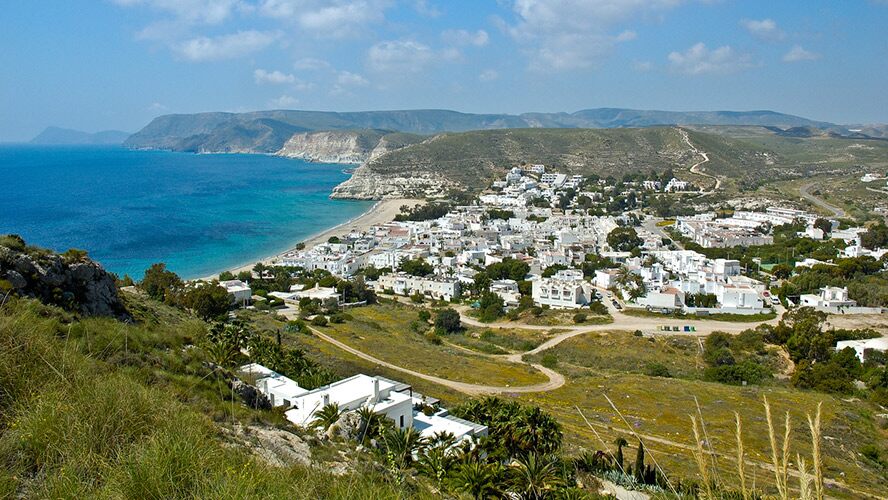
Canales de Padules
One of Almería’s most pleasant excursions takes us to the rock pools known as the Canales de Padules, in the midst of one of the province’s most luxuriant landscapes. These pools, located to the south of the village of Padules, have formed in the bed of the river Andarax, between the Sierra Nevada and the Sierra de Gádor.
They are concentrated within a 2-kilometre stretch, and it is worth taking your time to enjoy the flora and fauna of this Natural Monument. As there is a good chance that you will get wet, make sure you wear shorts and non-slip footwear. Along the way you will find some charming places, such as the Molino de la Abuela, an old mill converted into a bar, where you could have a snack and recharge your batteries. In the Padules area, not only can you enjoy some “aquatic” hiking: there are also places where you can put your climbing skills to the test.
Arrecife de las Sirenas
The Arrecife de las Sirenas is a reef, located close to the Cabo de Gata lighthouse, which exerts a hypnotic effect when seen from the viewing point. Watching as the sea batters the projecting rocks, and scattering foam has a relaxing and therapeutic effect. These rocky formations are ancient volcanic chimneys, lava that has solidified into strange shapes, which were mistaken for sirens by sailors long ago. These were not, in fact, mythological creatures, but monk seals who lived here.
Once you have taken photos from the viewing point, try walking along the path that leads down to the beach, directly opposite the reef. You will find yourself in a small cove, with limpid waters, ideal for snorkelling or just taking a dip. As the Arrecife de las Sirenas is very near Cabo de Gata beach, it’s a good idea to spend the rest of the day here on this stretch of the coastline, with its plethora of beach bars and good restaurants.
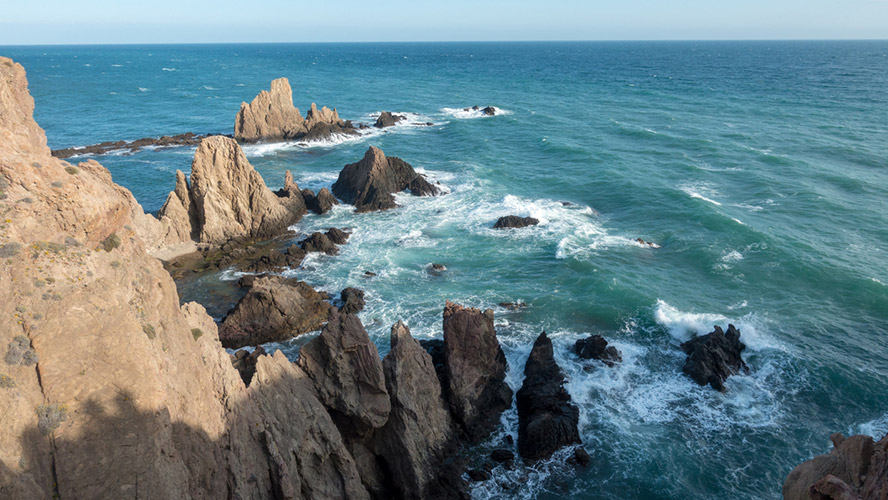
Lucainena de las Torres
Featuring on the list of the ‘Prettiest towns in Spain’ Association, this place has something to boast about. This little village of white houses exudes joy in its flower-bedecked streets. It has barely 500 inhabitants, who enjoy the peace and the natural setting of the Los Filabres-Tabernas comarca, while keeping alive their traditions. On any visit to Lucainena de las Torres, Lucainena de las Torres there are two attractions not to be missed: the village’s eighteenth-century church and the ‘coto minero’ — the old calcination furnaces that once purified the metal extracted by the area’s mines. And, of course, no visitor should leave without trying one of the area’s traditional dishes: ‘gurullos de conejo’, a rabbit stew made with a traditional sort of dumpling.
We hope you enjoy your visit to this province which, like Málaga, Huelva and Cádiz, will surprise you with its endless list of unmissable attractions.




































































